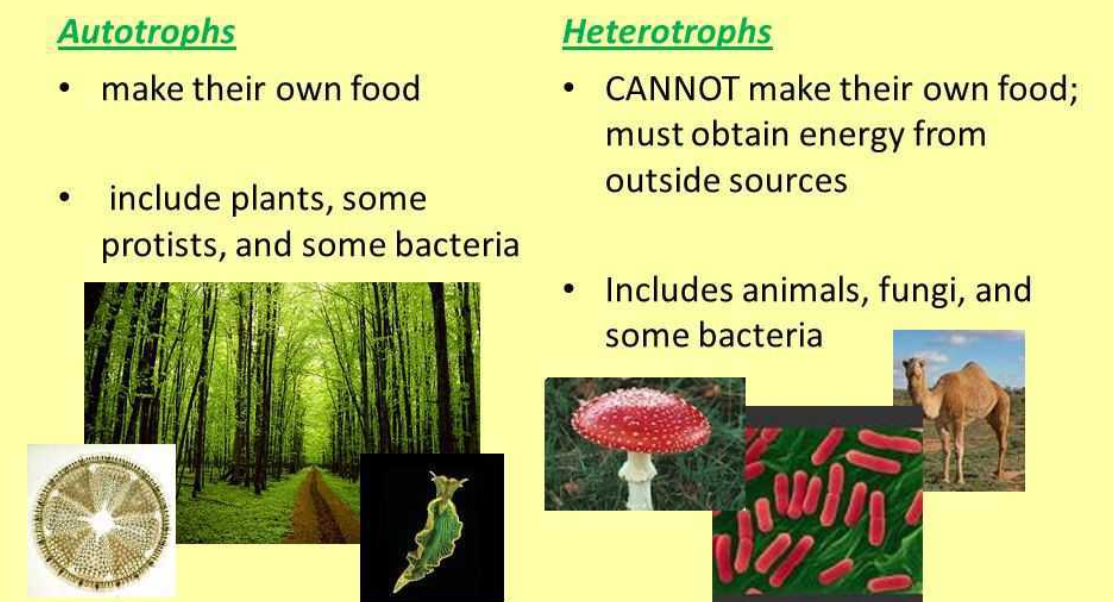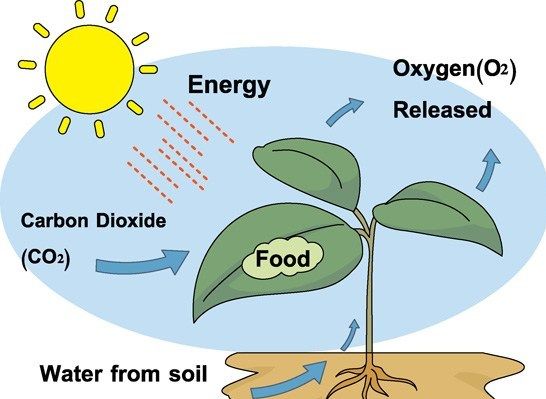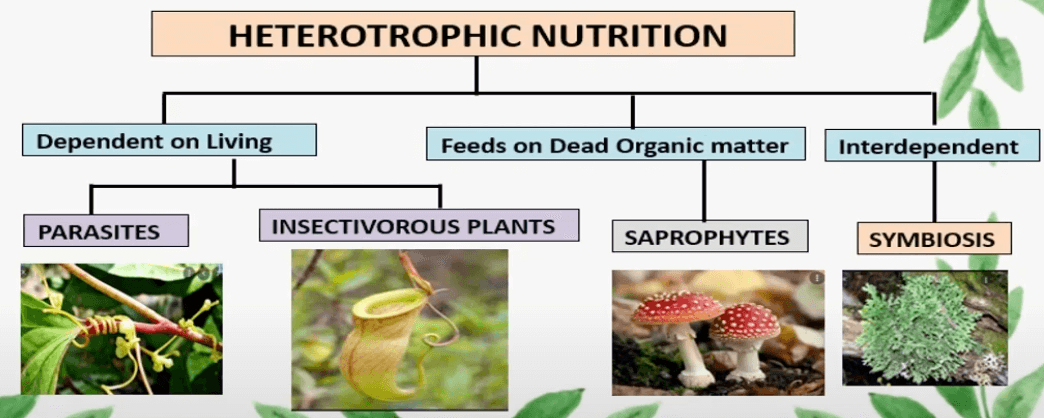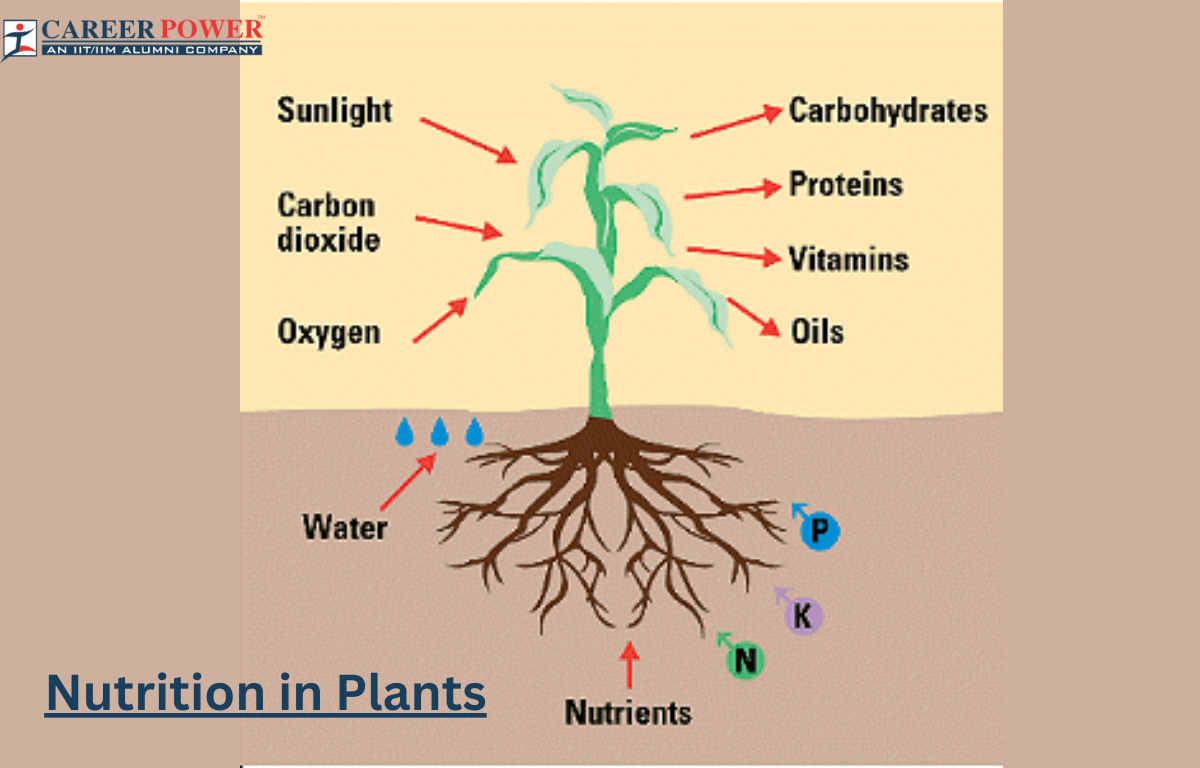Just like other organisms, plants also require food that can supply energy for their various metabolic activities. Though animals can move from one place to another in search of food, plants just stand still in one place and make their own food. As we already know that all plants are autotrophs and synthesize their own food through the process of photosynthesis. Where ‘Photo’ means ‘light’ and ‘synthesis’ means ‘to build’, thus ‘photosynthesis’ means ‘building up by light’.
Nutrition in Plants
Nutrition in plants is the process by which plants acquire the necessary substances for their growth and sustenance. Through photosynthesis, plants convert sunlight, water, and carbon dioxide into glucose and oxygen, using chlorophyll to capture sunlight energy. Additionally, roots absorb water and minerals from the soil, while leaves release excess water through transpiration. Plants respire to generate energy from glucose and absorb various nutrients from the soil for their metabolic needs. Some plants even form partnerships with nitrogen-fixing bacteria to access the nitrogen cycle.
Mode of Nutrition In Plants
Mode of nutrition refers to the way organisms obtain the nutrients they need for growth, energy, and maintenance. Mode of nutrition in plants can be broadly categorized into two modes: Autotrophic Nutrition and Heterotrophic Nutrition. Autotrophic organisms, like plants, produce their own food through photosynthesis. Heterotrophic organisms, like animals and many species of plants, rely on consuming other organisms or organic matter for nutrients.
| Mode of Nutrition in Plants | |
| Modes | Description |
| Autotrophic Nutrition | Plants make their own food using sunlight, water, and carbon dioxide through photosynthesis. They do not depend on other organisms for food and nutrients. |
| Heterotrophic Nutrition | Heterotrophic nutrition in plants involves obtaining nutrients by consuming organic matter from other sources. Heterotrophic nutrition is mainly of four different types- Insectivorous, Parasitic, Symbiotic, and Saprophytic. |

Autotrophic Nutrition in Plants
Autotrophic nutrition is a mode of nutrition in which organisms produce their own food using simple inorganic compounds, like glucose, from carbon dioxide and water, usually through the process of photosynthesis. Plants are a common example of autotrophic organisms. They use sunlight to convert carbon dioxide and water into glucose and oxygen, with the help of chlorophyll in their cells. This process allows them to create their own energy-rich molecules for growth, development, and other metabolic activities. Now let’s explain the process of photosynthesis.

Process of Photosynthesis
As we already know that photosynthesis is a complex process with multiple steps. The points mentioned below provide an overview of the key stages involved in converting light energy into chemical energy (glucose) in plants.

1. Light Absorption
- Plants contain chlorophyll pigments in their chloroplast, which absorb light energy from the sun.
- Other pigments, like carotenoids, also contribute to light absorption.
2. Light Reaction (Light-Dependent Phase)
- The light reaction takes place in the thylakoid membrane of the chloroplasts.
- Light energy splits water molecules into oxygen, electrons, and protons.
- Oxygen is released as a byproduct, while electrons are transferred along the electron transport chain.
3. Electron Transport Chain
- High-energy electrons move through protein complexes in the thylakoid membrane.
- Energy from electrons is used to pump protons (H+ions) into the thylakoid space, creating a proton gradient.
4. ATP and NADPH Formation
- Protons flow back into the chloroplast stroma through ATP synthase, producing ATP.
- Electrons reduce NAPH+ to form NADPH, a high-energy electron carrier.
5. Carbon Fixation (Calvin Cycle or Dark Reaction)
- Carbon fixation takes place in the stroma of the chloroplast.
- Carbon dioxide is captured and combined with a five-carbon compound (RuBP) in a reaction catalyzed by the enzyme rubisco.
- The resulting six-carbon compound immediately splits into two three-carbon molecules.
6. Reduction and Formation of G3P
- ATP and NADPH produced in the light reaction are used to convert the three-carbon molecule into Glyceraldehyde-3-Phosphate (G3P).
- Some G3P molecules are used to regenerate Rubp, while others proceed to produce glucose and other carbohydrates.
7. Regeneration of RuBP
- G3P molecules are rearranged and combined to regenerate the initial five-carbon molecule, RuBP.
- ATP from the light reaction provides energy for this regeneration process.
8. Glucose Formation and Oxygen Release
- Some G3P molecules are used to produce glucose and other sugars.
- Glucose is transported to other parts of the plant for energy storage and growth.
- Overall, the process releases oxygen into the atmosphere.
9. Overall Reaction
- The overall chemical equation or reaction of photosynthesis can be written as:
6CO2 + 6H2O + Light Energy → C6H12O6 + 6O2
10. Environmental Factors
- Temperature, light intensity, and availability of water influence the rate of photosynthesis.
Functions of Autotrophic Nutrition in Plants
Autotrophic nutrition in plants allows them to produce their own energy-rich molecules (glucose) using sunlight, carbon dioxide, and water. This process supports their growth, development, and the sustenance of the entire ecosystem.
- Photosynthesis: The primary function of autotrophic nutrition in plants is photosynthesis. Plants use light energy from the sun to convert carbon dioxide and water into glucose (a type of sugar) and oxygen. This process takes place in the chlorophyll-containing structures called Thylakoids.
- Energy Production: The glucose produced during photosynthesis serves as a source of energy for plants. Through cellular respiration, plants break down glucose and other organic molecules to release energy that fuels various metabolic processes within the plant.
- Storage: Excess glucose produced during photosynthesis is often stored as starch in various parts of the plant, such as roots, stems, and seeds. Starch serves as a reserve energy source that can be used actively occurring, such as during nighttime.
- Growth and Development: The glucose produced by photosynthesis is used to synthesize complex organic molecules like cellulose, proteins, and lipids. These molecules are essential for the growth, repair, and development of plant cells, tissues, and organs.
- Ecosystem Support: Plants with autotrophic nutrition form the foundation of the terrestrial ecosystem. They provide food and habitat for other organisms, contribute to nutrient cycling, and play a crucial role in maintaining ecological balance.
Heterotrophic Nutrition in Plants
Heterotrophic nutrition in plants refers to the process by which certain plants obtain nutrients from organic matter produced by other organisms. Unlike autotrophic plants that can produce their own food through photosynthesis, heterotrophic plants rely on external sources for nutrients. They usually obtain these nutrients by decomposing dead organic material or forming symbiotic relationships with fungi that help them absorb nutrients from their surroundings. This adaptation allows them to survive in environments with limited sunlight or nutrients. Heterotrophic nutrition is mainly of four different types: Insectivorous, Parasitic, Symbiotic, and Saprophytic.

| Types of Heterotrophic Nutrition in Plants | |
| Types | Description |
| Insectivorous Nutrition | Insectivorous nutrition is a survival strategy where certain plants capture and digest insects for nutrients. |
| Saprophytic Nutrition | Saprophytic nutrition involves obtaining nutrients by decomposing dead organic matter in the environment. |
| Parasitic Nutrition | Parasitic nutrition is when an organism or plant feeds on another organism or plant, harming the host for its sustenance. |
| Symbiotic Nutrition | Symbiotic nutrition refers to a mutually beneficial relationship between different organisms, sharing nutrients and resources. |
1. Insectivorous Nutrition in Plants
Insectivorous Nutrition is also known as carnivorous nutrition, as in this type of nutrition carnivorous plants capture and digest insects or other small organisms to obtain nutrients like nitrogen, which may be deficient in their habitat. Examples of insectivorous plants include Venus flytraps, Pitcher plants, and Sundew.
2. Saprophytic Nutrition in Plants
Saprophytic plants obtain nutrients from dead and decaying organic matter. They play a crucial role in breaking down and recycling nutrients in the ecosystem. The saprophytic plants are fascinating organisms that play a vital role in ecosystems by breaking down dead and decaying organic matter. One example of a saprophytic plant is the Indian Pipe (Monotropa Iniflora), and another example is the Ghost Plant (or Pine drops, Pterospora andromeda).
3. Parasitic Nutrition in Plants
Parasitic plants attach to the host plants and derive nutrients from them. They can either be their total parasite (obtaining all their nutrients from the host) or partial parasites (these plants still conduct some amount of photosynthesis). Or we can say that parasitic plants are unique botanical entities that have evolved to draw nutrients from other living plants. One of the well-known examples is the Dodder (Cuscutta species), and another example is the Broomrape (Orobanche species).
4. Symbiotic Nutrition in Plants
Symbiotic nutrition is also known as Mycoheterotrophic Nutrition. In this type of nutrition, plants form symbiotic relationships with fungi. These plants lack chlorophyll and cannot perform photosynthesis, so they rely on fungi to extract nutrients from the soil and deliver them to the plants. Examples include Pines, Ferns, and Orchids; as the pine tree and other conifers have mycorrhizal relationships.
Functions of Heterotrophic Nutrition in Plants
- Nutrient Absorption: Plants obtain essential nutrients such as minerals and organic compounds from external sources.
- Energy acquisition: Heterotrophic nutrition supplies the energy needed for various metabolic processes in the absence of photosynthesis.
- Respiration: Organic compounds acquired are used for cellular respiration, generating ATP, the energy currency of the cell.
- Adaptation to Varied Environment: Heterotrophic Nutrition allows plants to thrive in diverse habitats, including those with limited sunlight.
- Supplementing Photosynthesis: In some situations, heterotrophic nutrition complements photosynthesis, aiding the plant’s overall nutrient and energy intake.



 50 Vegetables Name for Kids in English a...
50 Vegetables Name for Kids in English a...
 Food Chain: Definition, Types, Examples,...
Food Chain: Definition, Types, Examples,...
 Human Respiratory System: Definition, Di...
Human Respiratory System: Definition, Di...













